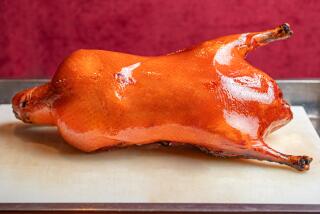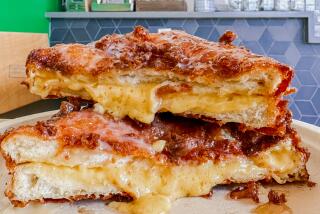Balut, Made With 18-Day-Old Duck Eggs, Is a Traditional Delicacy in Philippines
- Share via
MANILA — Eating a duck just before it quacks its first “quack” is considered a gastronomic delight in the Philippines, but one that may be disappearing.
Called balut, the dish is an 18-day-old duck egg, meticulously boiled so the duckling inside can be eaten--feathers, bones and all.
Filipinos love it because, they say, it makes their knees strong and stimulates their blood. Washed down with beer, it is a powerful aphrodisiac, old folks add.
That is why balut, which is also the name of the Philippines’ most popular dice game, is peddled in the evening in bus stations, to maids and drivers in neighborhoods for foreigners and at cockfights, at 4.5 pesos apiece (about 25 cents).
Offered by Street Vendors
Before going to bed, many await the shout of “ balut , balut “ from street vendors carrying rattan baskets with the hot eggs carefully wrapped inside.
Balut historians say the delicacy was brought by Chinese traders before Spain colonized the Philippines in the 16th Century.
Throughout the centuries, connoisseurs have made balut -making a profitable business, but that business is now being jeopardized by crime and even more lucrative ventures.
Most balut -making is done in the town of Pateros on Laguna de Bay. But today, commercial fishermen are taking over the bay for their enterprises.
Also, a rising crime rate in Manila is keeping balut vendors off the streets. A recent tabloid story told of a balut vendor fatally stabbed for refusing to give additional eggs to drunkards who had underpaid him.
‘The Only Job I Know’
“Some taxi drivers speed away without paying. Just two days ago one of my friends lost his basket to motorcycle-riding men,” vendor Alfredo Gallego said.
But he is unfazed. “I love this job. It’s the only job I know. I don’t want to rob or steal.”
He also is fond of the dish, eaten with a dash of salt.
There are about 50 balut factories in Pateros. One of the biggest, owned by Artemio Tuazon, produces about 300,000 balut eggs a week--down from 500,000 per week in the early 1970s. Production fell when Laguna de Bay was ringed by fish pens that deprived the duck raisers of their traditional source of snails, a staple duck food.
The factory, which employs only eight people, consists of a large, warm and dark room with a low ceiling that houses eight boxes 20 feet long, 3 feet wide and 3 feet deep.
Two rows of bamboo baskets are placed inside each box, and the spaces between are filled with rice husk. Each basket, cemented on the inside by carabao (water buffalo) dung, serves as an incubator.
Fresh duck eggs, heated under the sun to a temperature of about 40 degrees Centigrade, are arranged in 10 layers inside each basket for incubation. Two bags of pan-fried palay grains are placed on top to add heat.
Determining Fertile Eggs
After nine days, the “first candling” is done by placing the egg against the light of an electric bulb to determine the fertile eggs from the rotten ones.
On the 18th day of incubation, the “second candling” is performed, and those ready for marketing are separated from the younger eggs.
“I have to maintain a temperature near 40 degrees (Centigrade). A slight addition of heat or lack of it would destroy the eggs,” said Jacinto Borja, 56, a balut maker for the past 31 years.
With a steady supply of fresh eggs, the arrangement in the incubators has to be rotated every day to accommodate the new batches without altering the temperature.
To do this, Borja places the 9-day-old eggs on top of the layer, followed by fresh eggs, then by 6-day-old ones, then by fresh eggs, then 3-day-old ones and so forth.
Bags of pan-fried palay grains are placed alongside the bags of eggs in each incubator to give constant heat.
More to Read
Eat your way across L.A.
Get our weekly Tasting Notes newsletter for reviews, news and more.
You may occasionally receive promotional content from the Los Angeles Times.








